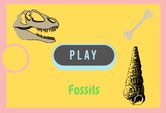Fossils Game Quiz Online
This page features a Fossils Game Quiz Online. It is an exercise for students studying science in 3rd, 4th, 5th, 6th to 8th grades. Students will learn about finding fossils and more. Remember to learn more by reading the article below.

How to Find Fossils
Fossils are the preserved remains, or traces of remains, of ancient organisms. The probability of finding a fossil is extremely small, but not non-existent. This article will cover Trace fossils, Index fossils, and Extinct animals. Once you have a general idea of what fossils are, you can choose the type of fossil you want to find and start digging. Here are some great tips to help you begin your search. Hopefully, by the end of this article, you'll be a fossil hunting pro!
Extinct animals
We don't know how long ago a species of animal died out, but we do know that some of its remains were preserved in the fossil record. Studies found that the extinction of a mammal, for example, was more probable without fossils than with them. In one study, authors compared the Red List, which is the most comprehensive listing of endangered species, to three paleontological databases. The findings showed that the extinctions of the most threatened species were the ones that were most likely to be left without fossil records.
The process of fossilization left behind in the bones of extinct animals can provide information about their function. For example, the fossil skeleton of an arthropod may reveal the size, shape, and number of its limbs. Other fossils of the same animal may reveal details about its mouthparts, locomotion, and feeding habits. Sometimes, exceptionally preserved fossils will reveal tentacles of belemnite or hair, and even muscle tissue in vertebrates.
One of the most amazing discoveries of the past few decades is the discovery of the bones of a giraffe 2,600 years ago. The reconstruction is a stunningly accurate representation of a once-thriving animal. It was the first scientifically accurate reconstruction of an extinct animal, and it introduced the method of reconstruction. Cuvier accompanied his work with plates showing assembled skeletons. Cuvier attempted to breathe life into ancient bones by covering them with skin, fur, and muscles. While his drawings were incredibly accurate and detailed, he was hesitant to publish them.
Trace fossils
The term "trace fossils" refers to the traces of animals found during the geological history of the Earth. These traces record the behavioral characteristics of various vertebrates. They include tracks, trails, burrows, feeding traces, and locomotion. These trace fossils represent the interaction between the vertebrates and their environments. To understand the evolution of life on Earth, a better understanding of trace fossils is essential.
Although the term ichnotaxonology is often used to describe the types of organisms that lived in a certain area, it has no standardized theoretical basis. The existing problems are classified and suggested solutions. Ideally, the ichnotaxobases of trace fossils should match their biological relationships. Similarly, the hierarchical systems should contain only the principal types of substrate. Finally, ichnology and paleobotany are used to resolve discontinuities of stratigraphic significance.
There are two classification systems for trace fossils. The Ethological System uses behavior indicators to classify trace fossils, while the Toponomic System considers the relationship between a trace fossil and its sediment. The former is generally preferred. In addition to being more accurate, this classification system helps scientists understand how the fossils were formed. It is important to note that not all marks are trace fossils. Some marks are simply toolmarks that have been preserved in sediments.
Index fossils
To understand the importance of index fossils, you should know what makes a good specimen. Fossils of animals and plants are the basis of fossil collections. They provide information on the ages and extinction rates of different organisms. Many organisms, such as birds, make poor index fossils because their skeletons break easily and are easy to degrade. Only fragments of these organisms survive in the fossil record, which makes it difficult to identify a particular species.
The best index fossils are relatively common and widespread. Their species-level classification makes them easy to identify. This is because the probability of finding them is low. Some examples of index fossils include acritarchs, a group of tiny, organically walled microfossils. Regardless of their appearance, they are excellent examples of phylogenetic relationships.
If you're planning to study fossils from the Paleozoic Era, these fossils will help you understand the history of the planet. A good index fossil must have a unique appearance and be easy to recognize in the field. Field geologists prefer to look for fossils that are visually distinguishable. This means that a trilobite, for example, would be an excellent index fossil. Trilobites are marine arthropods with rounded heads and segmented bodies. Their different characteristics make them unique and useful for determining the age of a rock layer.
